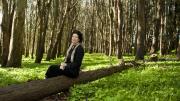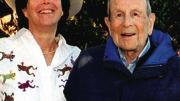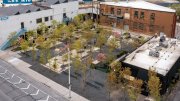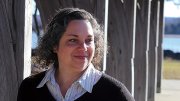Growing up in San Francisco, Laurie Wayburn ’77 rarely attended church on Sundays. Instead, she and her family went hiking. Mount Tamalpais State Park, Muir Woods, and the Point Reyes National Seashore--among the most diverse and beautiful landscapes in the nation--are all within easy reach of the city and quickly became as familiar to her as her own backyard. “We were raised in that environment,” she says. “Nature was our church.”
Now president and co-CEO of the Pacific Forest Trust (PFT), Wayburn is still a convert--and one of the more innovative conservationists in the environmental field. “Everyone loves to be outside; nature is where we all come from, and even through millions of years of evolution, we still respond to it,” she says. “Nature is central to our emotional, physical, and spiritual wealth and well-being. A central motivating force for me in this work is creating a resonance with that part of our lives at a very basic economic level: building an understanding that nature is where our wealth comes from.”
To marry these cultural and economic realities, Wayburn and her partner, Constance Best (who co-founded PFT with Wayburn in 1993), have focused on conserving working forests. And through pioneering a conservation easement specifically for land still in production, they have found a way to reward landowners who engage in sustainable timber harvesting and long-term stewardship that preserves forests’ critical role in removing greenhouse-gas emissions, providing clean water and habitats, and stabilizing the environment. “It’s the old ‘You can have your cake and eat it, too,’” says former PFT board member Walter Sedgwick ’69. “There are people who want to protect and set aside forests through organizations like the Save the Redwood League, the Sierra Club, and the Nature Conservancy, which tend to buy forest and let it grow, and people who would cut down the forests in short rotations and monetize the resources.” PFT’s approach has brokered a middle ground in what has always been an extremely polarized, politicized arena.
“What’s different about Laurie and Connie,” Sedgwick adds, “is that they said, ‘We can get almost all we want in terms of biodiversity and conservation values, but we can also cut.’ The real enemy of the forests is not the big timber companies, but the permanent conversion of those forests into sprawl. From Laurie’s point of view, the landowners are the good guys.”
As Wayburn, who spends a lot of time with state and federal politicians these days, puts it: “I’ve found that a love of the land is inherently bipartisan; but so is a love of money. If you love land and you love money, this is a way to have both.”
In numeric and environmental terms, the stakes are very high. Forests cover one-third of the United States--and two-thirds of them are in private hands, so there are only nominal regulatory controls over their development. Forests fuel the nation’s $130-billion timber industry, delivering basic products and critical rural jobs. “Every year, forestlands the size of Delaware are being destroyed,” Wayburn says, “and nobody wakes up realizing what that really means to our world. Frankly, you can create alternatives for a variety of timber products out of other plants and materials through recycling--but you cannot replace the clean air and clean water that forests nurture.” She believes American culture is slowly evolving into a society that recognizes the need to pay for what it really needs--a stable, resource-rich environment.
PFT’s work on two fronts--developing and practicing direct land conservation services, and promoting public policies for sustainable forestry--is meant to speed this cultural evolution. Forests are like an old-fashioned bank account, Wayburn likes to say: “They grow on their own, if we let them. But we need to apply conservative banking principles to our forest management: conserve and re-grow the principal.”
The privately owned Van Eck Forest, for example, is a 2,200-acre tract that PFT manages and conserves in Humboldt County. It is a testing ground and model for PFT’s brand of stewardship, and was the first emissions-reduction project registered in California under that state’s new carbon-accounting standards, which PFT was instrumental in drafting, in 2006. The system rewards landowners for responsible harvesting practices by allowing them to sell carbon credits from forests in the carbon market created by the state’s landmark legislation. At the same time, under its working easement, the Van Eck Forest is projected during the coming century to reduce more than 500,000 tons of CO2 emissions through sustainable forestry techniques that sequester more carbon than conventional methods do.
Recently, PFT took this easement principle a step further toward species preservation and habitat formation. Two endangered northern spotted owls have been seen on the property, engaging in behavior that typically leads to nest building, Wayburn says. (She has vast knowledge of bird life and was executive director of the Point Reyes Bird Observatory before founding PFT.) Typically, in such a case, timber production would be restricted under the Endangered Species Act--a source of tension and conflict between landowners and conservationists. But because PFT’s easement was already in place--and had, in fact, helped foster a habitat that drew the birds in--the U.S. Fish and Wildlife Service recognized the easement’s inherent value and PFT was able to use that to negotiate a 99-year Safe Harbor Agreement that did not interfere with planned logging on the land.
The negotiation also heartens Wayburn because it affirms the possibility of finding and forging common ground. “The number of forests that are conserved versus the number lost to development--that’s very depressing,” Wayburn notes. “So I prefer to focus on creating situations where there is a win-win-win. A lot of this work depends on how you look at your opportunities, saying, ‘How can I find a friend here?’ ‘How can we work together?’ That’s my approach.”
In January, Wayburn led a “working lands coalition” (forest landowners, mill owners and environmentalists) to Washington, D.C., to advocate for the inclusion of forests in climate and energy legislation. Group members stressed the need to maintain and increase jobs in the declining wood-products industry in order to reduce pressure on landowners to sell forest tracts for development. Specifically, they said, the climate bill should include: an accurate accounting of carbon stored in and emitted by the nation’s lands; acknowledgment of emissions reductions from forests in any climate policy; and funding for conservation and stewardship to protect essential infrastructure that reduces carbon emissions.
Now that she is more immersed in developing policy, Wayburn misses working directly with private landowners. “One of the fun things is that many of them really love their land and keep logs on what birds return and what flowers bloom first,” she notes. “They are deeply attuned to aspects of their own property and are knowledgeable about what happens there from an ecological point of view. That always makes it a real pleasure to go out walking with them.”
Colleagues say that Wayburn herself can identify most of the local plants, trees, and birds outside the PFT office, at the Thoreau Center for Sustainability in San Francisco’s Presidio, near the Golden Gate Bridge. It is not unusual for her to stop mid-sentence to listen to a bird’s call. “Getting ourselves back in touch with the natural world,” she says, “is enormously powerful.”
Maybe even more so for her than for other people. Hampered throughout her teens by chronic pneumonia and kidney diseases, Wayburn spent a lot of time in the hospital. Trips outdoors to see birds and open sky, or study insects on the forest floor, were comforting. “I’m a big softie about animals--we have two mice, one magnificent cat, and a delightful dog, in addition to our nearly eight-year-old child,” she says. “I think animals make us human.”
At Harvard, where she transferred after a year at the University of California-Davis, Wayburn worked closely with Agassiz professor of zoology and professor of biology Farish A. Jenkins Jr., spending most of her time at the Museum of Comparative Zoology “pulling out drawers of dead birds and studying their skins.” She concentrated in geology and biology, but would have chosen ecology had that been an option.
Some might argue that such formal study was less valuable than what she’d already learned growing up with her parents, Peggy and Edgar Wayburn, M.D. ’30, a renowned conservationist and former Sierra Club president who died in March, at the age of 103. Campaigns that he led ultimately protected about 104 million acres of Alaskan wilderness and huge tracts throughout Northern California, including the places his daughter still loves to hike. He was also a prime mover in establishing the Golden Gate National Recreation Area, and had the foresight to push to have the Presidio, a nearly 1,500-acre former military base at the foot of the bridge, added in time.
Her father also influenced her decision to transfer to Harvard, “because he had such a wonderful time there,” she explains. Yet Wayburn says she felt like a foreigner in Cambridge and gravitated toward the international students. That eventually led her to work on environmental issues in Africa for the United Nations after graduation. In Kenya, she realized two things: that the working environment--when integrated into the real lives of real people--is not “about a pretty postcard or a pristine landscape”; and that the goal of environmental sustainability should be to work with what exists already. “That means, for example, not necessarily bringing in sheep, goats, and cattle, which come from a European context,” she explains, “but working with what’s native, with whatever natural grains can grow in small patches with less water. Environmentalism is about looking at the natural diversity and developing solutions within an existing context.”
This thinking is evident throughout one of PFT’s most recent conservation initiatives, for the Klamath-Cascade region, which runs from northern California across the slopes of Mount Shasta and into Oregon. These 9.8 million acres, half publicly owned, “contain the most biodiverse conifer forest in the world,” Wayburn says. “The region is the source of two-thirds of California’s drinking water--and most people don’t even know it exists.” This valuable “wood basket” also produces up to 75 percent of the timber harvested in California annually. “This is a prime opportunity to knit together different aspects of conservation,” she reports: “a functional landscape in which we can grow a natural resource and sustain the economy--in an area that still has large ownership on the private side, as well as relatively low population and nice weather--which means it is under huge development pressures.” The region is still fairly intact, but PFT is working closely with stakeholders and affected communities, seeking to create a “greenprint” to guide a truly viable future.
The Presidio, where Wayburn works every day, would not have become a federal park had others before her not had the same foresight to develop it responsibly. Five minutes’ walk from her office is a stand of 30-foot coastal redwood sequoias known as the Wayburn Grove, dedicated to her parents; to celebrate her father’s hundredth birthday, her son, Elliott, helped plant another one. Wayburn sees her own work as carrying on not so much his legacy but his spirit. “Perhaps his greatest gift was showing that if you have a vision, pursue it--it’s possible to make it happen,” she says. “He was a marvelous man who seized the opportunities of his time, just as we have to seize them relative to ours.”










